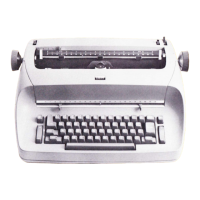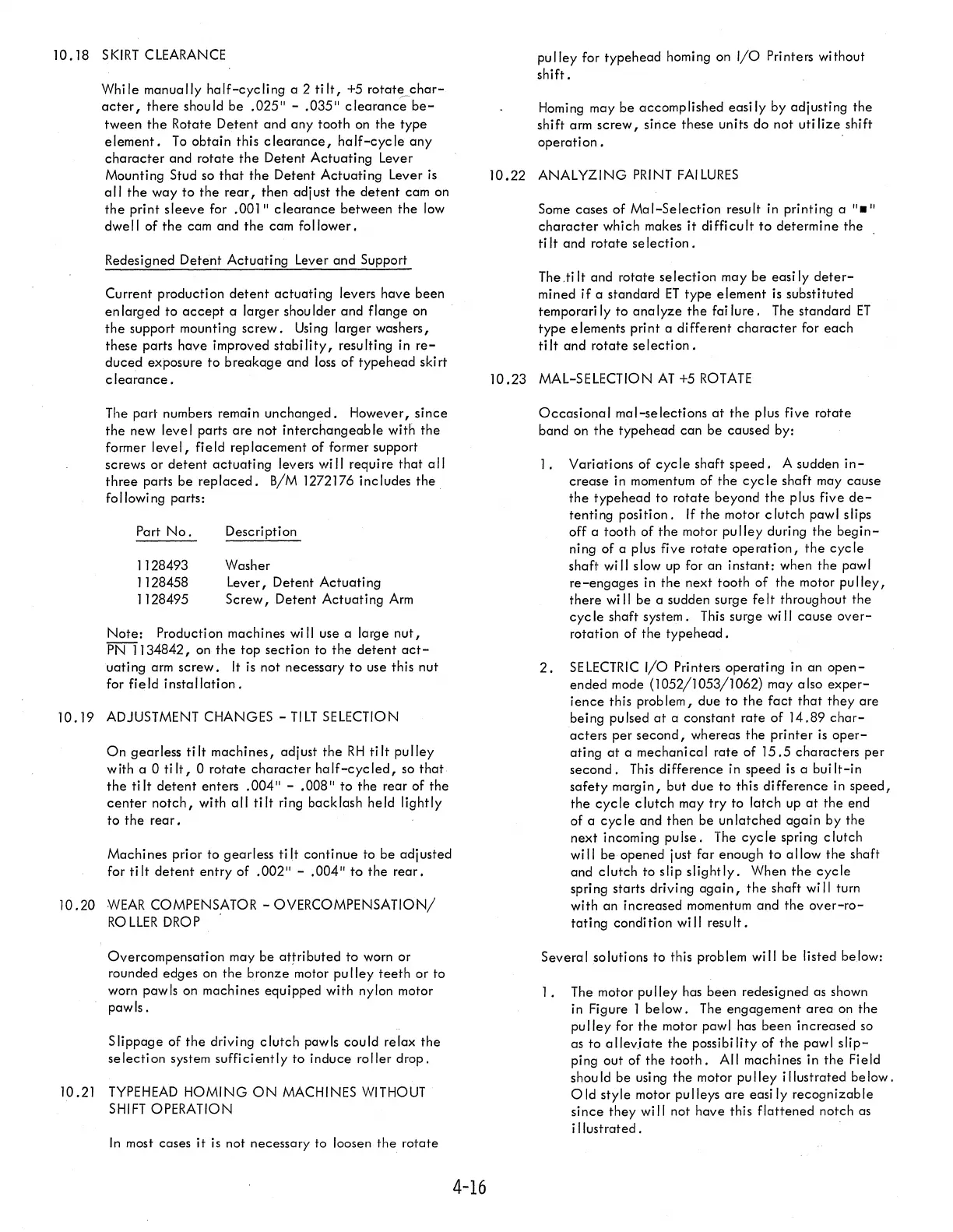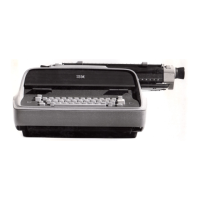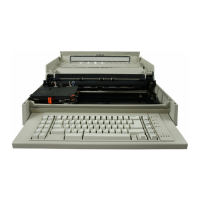10.18
SKIRT
CLEARANCE
While
manually
half-cycling
a 2
tilt,
+5
rotate
char-
acter,
there
should be .025" - .035"
clearan~be
tween
the
Rotate
Detent
and
any
tooth
on
the
type
element.
To
obtain
this
clearance,
half-cycle
any
character
and
rotate
the
Detent
Actuating
Lever
Mounting Stud so
that
the
Detent
Actuating
Lever is
all
the
way
to
the
rear,
then
adjust
the
detent
cam on
the
print
sleeve
for .001
II
clearance
between
the
low
dwell
of
the
cam and
the
cam
follower.
Redesigned
Detent
Actuating
Lever
and
Support
Current production
detent
actuating
levers have
been
en larged
to
accept
a larger shou Ider
and
flange
on
the
support mounting
screw.
Using larger washers,
these parts
have
improved stabi
lity,
resu Iting in
re-
duced
exposure
to
breakage
and loss
of
type head skirt
clearance.
The
part
numbers remain
unchanged.
However,
since
the
new
level
parts
are
not
interchangeable
with
the
former
level,
field
replacement
of
former support
screws or
detent
actuating
levers
wi
II
require
that
all
three
parts
be
replaced.
B/M 1272176
includes
the.
following parts:
Part
No.
1128493
1128458
1128495
Description
Washer
Lever, Detent
Actuating
Screw,
Detent
Actuating
Arm
Note:
Production machines
wi"
use a large
nut,
PN 1134842, on
the
top
section
to
the
detent
act-
uating
arm
screw.
It is not necessary
to
use this nut
for
field
installation.
10.19 ADJUSTMENT CHANGES -
TILT
SELECTION
On
gearless
tilt
machines,
adjust
the
RH
tilt
pulley
with a 0 ti
It,
0
rotate
character
half-cycled,
so
that
the
tilt
detent
enters .004" - .008"
to
the
rear
of
the
center
notch,
with
all
tilt
ring backlash held lightly
to
the
rear.
Machines
prior to gearless ti
I.t
continue
to be adjusted
for ti
It
detent
entry
of
.002" - .004"
to
the
rear.
10.20
WEAR
COMPENSATOR -
OVERCOMPENSATION/
RO
LLER
DROP .
Overcompensation
may
be
attributed
to worn
or
rounded edges on
the
bronze
motor pu IIey
teeth
or
to
worn pawls on machines equipped with nylon motor
pawls.
Slippage
of
the
driving
clutch
pawls
could
relax
the
selection
system
sufficiently
to
induce
roller
drop.
10.21
TYPE
HEAD
HOMING
ON
MACHINES WITHOUT
SHIFT
OPERATION
In
most cases
it
is not necessary to loosen
the
rotate
4-16
pulley
for
typehead
homing on
I/O
Printers without
shift .
Homing may be accomp lished easi
Iy
by adjusting
the
shift arm
screw,
since
these units
do
not uti Iize shift
operation.
10.22
ANALYZING
PRINT
FAILURES
Some
cases
of
Mal-Selection
result in printing a
"."
character
which makes
it
difficult
to
determine
the
ti
It
and
rotate
se
lection.
The.tilt
and
rotate
selection
may
be
easily
deter-
mined
if
a standard
ET
type
element
is
substituted
temporari
Iy
to
ana
Iyze
the
fai
lure.
The standard
ET
type
elements
print a
different
character
for
each
ti It
and
rotate
se
lecti
on.
10.23 MAL-SELECTION
AT
+5
ROTATE
Occasional
mal-selections
at
the
plus five
rotate
band on
the
typehead
can
be
caused
by:
I.
Variations
of
cycle
shaft
speed.
A sudden
in-
crease
in momentum
of
the
cycle
shaft may
cause
the
typehead
to
rotate
beyond
the
plus five
de-
tenting
position.
If
the
motor
clutch
pawl slips
off a tooth
of
the
motor
pulley
during
the
begin-
ning
of
a plus five
rotate
operation,
the
cycle
shaft
wi
II
slow up for an
instant:
when
the
pawl
re-engages
in
the
next
tooth
of
the
motor
pulley,
there
wi
II
be
a sudden surge fe It throughout
the
cyc
Ie
shaft system. This surge
wi
II
cause
over-
rotati
on
of
the
type head .
2.
SELECTRIC
I/O
Printers
operating
in an
open-
ended
mode (1052/1053/1062) may
also
exper-
ience
this prob lem,
due
to
the
fact
that
they
are
being pulsed
at
a
constant
rate
of
14.89
char-
acters
per
second,
whereas
the
printer
is
oper-
ating
at
a
mechanical
rate
of
15.5
characters
per
second.
This
difference
in
speed
is
a bui
It-in
safety
margin,
but
due
to this
difference
in
speed,
the
cycle
clutch
may
try
to
latch
up
at
the
end
of
a
cycle
and
then
be
unlatched
again
by
the
next
incoming
pulse.
The
cycle
spring
clutch
will be opened just far enough
to
allow
the
shaft
and
clutch
to
slip
slightly.
When
the
cycle
spri ng starts drivi
ng
again,
the
shaft wi
II
turn
with
an
increased momentum
and
the
over-ro-
tating
condition
wi
II
result.
Several
solutions
to
this problem will be listed below:
I.
The motor
pulley
has
been
redesigned as shown
in Figure I
below.
The
engagement
area
on
the
pu
lIey for
the
motor pawl has
been
increased
so
as
to
a lIev.iate
the
possibi Iity
of
the
pawl
slip-
ping
out
of
the
tooth.
All machines in
the
Field
shou
Id
be
usi
ng
the
motor pu lIey
illustrated
be low.
Old
style
motor pu lIeys
are
easi
Iy
recognizable
since
they
will not have this
flattened
notch as
illustrated.
.

